I originally chose to explore a book called Penguins by Stephen Martin because it wasn’t a typical national geographic book, rather it detailed the history of penguins and how they are presented in the media. However, I decided to change this book, because I felt making an aesthetic link between the texture of the penguin’s feathers and textures found in artists/designer’s work was not a strong idea. However, this led me to visit another of my favourite books titled Alexander McQueen: Edited by Claire Wilcox. This book presented detailed information about McQueen’s work as well as documenting all McQueen’s collections from his graduate collection to his last collection titled Angels and Demons in 2010.
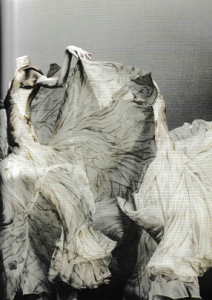
Garment from Alexander McQueen’s last collection Angel’s and Demon’s 2010, originally modelled by Irina Kulikova. Featured in the Alexander McQueen Savage Beauty exhibition: At the V&A 14th of March – 2 August 2015. Photographer unknown.
I found my chosen image was a piece from McQueen’s final collection because I recognised another piece that was displayed with my chosen image at the exhibition. I then proceeded to search the internet for more information. It took some time to locate any useful information as I found footage on YouTube of the runway show of the collection however, this was purely visual and did not provide the information I wanted. I then searched Vogue magazine articles and found the name of the model Irina Kulikova, who wore my chosen piece at the runway show however, I wanted to find information about the inspiration and the fabrics of the piece. I eventually came across an article at Popsugar.com which included quotes by Sarah Burton, Alexander McQueen’s creative director who worked closely with McQueen, who gave details about his process and inspiration.
Burton detailed about how McQueen had “turned away from the world of the internet” and how “He wanted to get back to the hand craft that he loved”. My chosen piece had the angels of Botticelli and the demons of Hieronymus Bosch woven into the fabric, which I found out from this article. This was an informative discovery as I now had details about McQueen’s inspiration. To further my knowledge, I researched Botticelli’s paintings and McQueen’s angels and demons collection on the V&A Museum’s website.
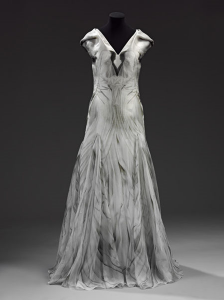
Alexander McQueen Dress from McQueen’s Angels and Demon’s 2010 collection. exhibited and stored at the V&A Museum, London.
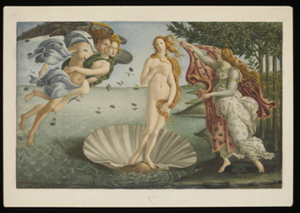
The Birth of Venus, painting by Sandro Botticelli (mid 1480s), Exhibited at the V&A Museum, London.
I found my chosen piece along with detailed descriptions about the fabric and it included the same Sarah Burton quotes that I originally found on the Popsugar.com article, assuring that this article was reliable.
I feel It’s ironic that McQueen’s last collection is arguably about the afterlife, because my immediate interpretation is that McQueen somehow predicted the events that led to his own death. However, with further research into the interpretations of Botticelli’s paintings of angels and Bosch’s paintings of demons, gave me a further understanding of what McQueen thought about his inspiration. I now understand more about this collection and now interpret that McQueen wanted to combine good and bad elements because McQueen found beauty in both. I feel these themes complement each other, but are also harmonious because they are like two sides of the same coin, as both aspects of McQueen’s inspiration are part of the same subject and demonstrate that one cannot exist without the other.
Bibliography
Vogue (2010) Alexander McQueen. Available from: http://www.vogue.co.uk/shows/autumn-winter-2010-ready-to-wear/alexander-mcqueen [Accessed 16/10/2017]
McQueen’s final collection titled Angels and Demons, images of collection posted on Vogue website.
Victoria and Albert Museum (date unknown) Savage Beauty in Numbers. Available from: http://www.vam.ac.uk/content/exhibitions/exhibition-alexander-mcqueen-savage-beauty/video-savage-beauty-in-numbers/ [Accessed 16/10/2017]
Alexander McQueen: Savage Beauty exhibition – video promoting exhibition, no real explanation of pieces.
Vogue (2010) fall 2010 ready-to-wear. Available from: https://www.vogue.com/fashion-shows/fall-2010-ready-to-wear/alexander-mcqueen/slideshow/collection#11 [Accessed 16/10/2017]
Found the model who wore McQueen’s dress, Irina Kulikova.
IMG Models (date unknown) Irina Kulikova. Available from: http://www.imgmodels.com/model/paris/women/19255[Accessed 16/10/2017]
Found Irina Kulikova’s portfolio on IMG models website. However, McQueen’s dress is not featured in her portfolio.
Popsugar Fashion News (2010) Lee Alexander McQueen’s Final Collection For Fall 2010: All Angels and Demons. Available from: https://www.popsugar.com/fashion/Lee-Alexander-McQueen-Final-Collection-Fall-2010-All-Angels-Demons-7692975 – [Accessed 18/10/2017]
Popsugar.com article about McQueen’s collection with quotes from Sarah Burton detailing his inspiration and process.
Web Gallery of Art (1996) Picture Data. Available from:https://www.wga.hu/cgi-bin/search.cgi?author=Botticelli&title=angels&comment=&time=any&school=any&form=any&type=any&location=&format=5[Accessed 18/10/2017]
The web gallery of art website with seemingly authentic images of Botticelli’s works which include paintings McQueen could have been inspired by
Web Gallery of Art (1996) Madonna and Child and Two Angels. Available from: https://www.wga.hu/html_m/b/botticel/1early/08madonn.html [Accessed 8/10/2017]
Specific image of interest from website.
V&A (2017) Dress. Available from: http://collections.vam.ac.uk/item/O1193821/dress-alexander-mcqueen/ [Accessed 18/10/2017]
Detailed description of the specific dress from McQueen’s Angels and Demons collection from the V &A website.
V&A (2017) copy after the Birth of Venus by Sandro Botticelli in the Uffizi (Florence). Available from: http://collections.vam.ac.uk/item/O205978/copy-after-the-birth-of-watercolour-botticelli-sandro/ [Accessed 18/10/2017]
Detailed description of the painting The Birth of Venus from the V&A website.
V&A (2017) V&A Search The Collections. Available from: http://collections.vam.ac.uk/search/?extrasearch=&q=Hieronymus+Bosch&commit=Search&quality=0&objectnamesearch=&placesearch=&after=&before=&namesearch=&materialsearch=&mnsearch=&locationsearch= [Accessed 18/10/2017]
searches for Hieronymus Bosch’s works, the other artist that inspired McQueen’s Angels and Demons collection.
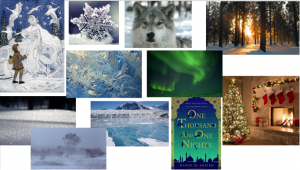

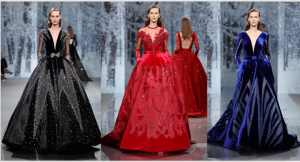
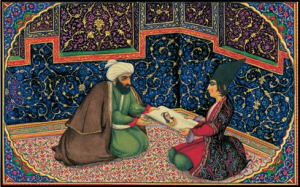
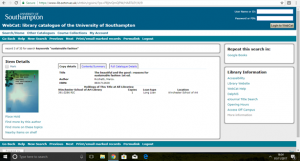
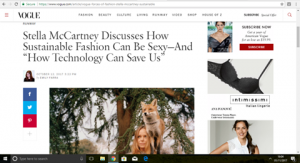
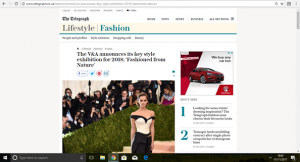



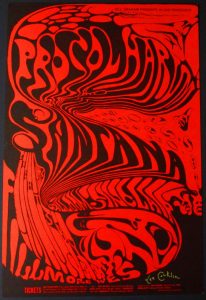
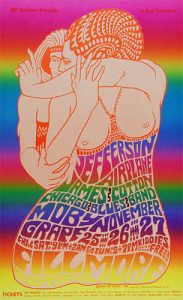
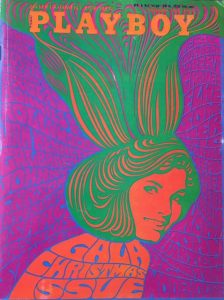
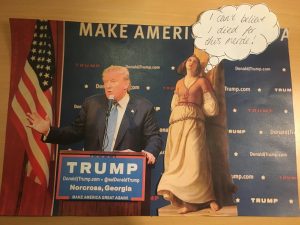
 Avant-garde is a
Avant-garde is a  with the broadness of the term and our new ways of sharing information i’d argue that avant-garde is still alive and kicking, although many artists borrow from one another a majority of artists seem to be capable of going on their own personal movements, many gaining notoriety and praise for innovation and expression and even inciting messages and ideas to society via social media and id also argue game design has become more avant-garde now than ever before, of course there have been many classics in game innovation (super Mario 64, Ocarina of time, oddworld: abes oddyssey, shadow of the colossus, okami etc) but the rise in indie/independent game development along side art directors taking centre stage in larger companies ‘artistic video games’ are now more prevalent than ever.
with the broadness of the term and our new ways of sharing information i’d argue that avant-garde is still alive and kicking, although many artists borrow from one another a majority of artists seem to be capable of going on their own personal movements, many gaining notoriety and praise for innovation and expression and even inciting messages and ideas to society via social media and id also argue game design has become more avant-garde now than ever before, of course there have been many classics in game innovation (super Mario 64, Ocarina of time, oddworld: abes oddyssey, shadow of the colossus, okami etc) but the rise in indie/independent game development along side art directors taking centre stage in larger companies ‘artistic video games’ are now more prevalent than ever.